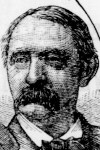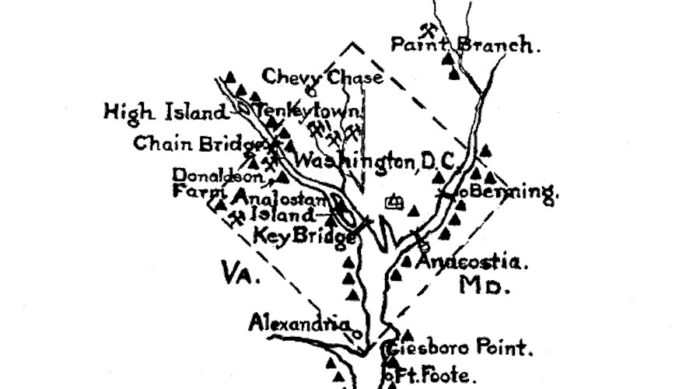
Over the last few weeks, we have been slowly getting closer to the real crux of our story: Where did indigenous people live on Capitol Hill before the Europeans showed up? Today, we will look at the best evidence found in that direction.
In the L’Enfant plan, there is an open space almost directly south of the Capitol, and bisected by the road that would become New Jersey Avenue. It was marked with the letter E and the legend states that this land would house “Five grand fountains intended with a constant spout of water.”
As with so many ideas L’Enfant put to paper, this did not happen. While New Jersey Avenue soon became the main street of Capitol Hill, the open land, now known as Reservation 17, remained unused. Things went further down when the Baltimore & Potomac Railroad line was run just south of the reservation, with a small rail yard added. It was only under Alexander Shepherd’s rule that there finally was a push to turn L’Enfant’s vision into reality. This was not an easy task, because the land had within it a fairly steep bank as well as some low-lying areas that were headwaters of the James Creek.
What was necessary was a lot of grading, which required a lot of manpower – and a lot of money. Starting in 1875, the government successively appropriated large sums to this end. Under the direction of Colonel Almon Rockwell, the Superintendent of Public Buildings (pictured above), work proceeded, with short items every year in the newspapers of the time marking the slow progress.
The only time there was a longer article came in the summer of 1883, when some surprising finds were made. The Washington Post published an article on August 12, which consisted of an interview by the Post reporter with the “superintendent of reservation no. 17.” The superintendent explained that they had dug down about eight or nine feet, and had come across some bones, which were taken to a Dr. Clark in Alexandria, who determined that they were “the bones of a girl, probably an Indian girl, about twelve or fourteen years old.” Along with the bones, a stake had been found, one end “rudely sharpened,” while the other end had been “rubbed smooth by a rope or a stout vine, used in tieing a boat to the stake,” as the superintendent explained to the reporter.

Also found was a clay deposit that had the appearance of Castile soap, though not that substance’s cleaning properties, as one gentlemen discovered when he took some home.
Ten days later, the Evening Star reported on the same finds, though in a much more concise manner and without adding any further information. This led to a snarky item the following day in the Post:
A workman employed on the improvements of reservation 17 (Garfield park) states that the alleged recent discoveries there must have consisted in the digging up of a copy of The Washington Post of August 12, 1883, wherein all the discoveries to date were described.
Sadly, that is all the information we have about this possible settlement on Capitol Hill. A 1935 article in the Star about the indigenous people of the District has the tantalizing sentence, “It is said that the eminence on which the Capitol now stands was used by the Indians for their council fires.” but does not indicate who says this, or on what evidence it is based. They quite rightly conclude that “[t]he devastating hand of Time has obliterated their villages, for they were built but of wood and bark and wattles, and in the scrap heaps of the proud Indians the savants of today must dig, in an effort to reconstruct their life for the benefit of science.”
